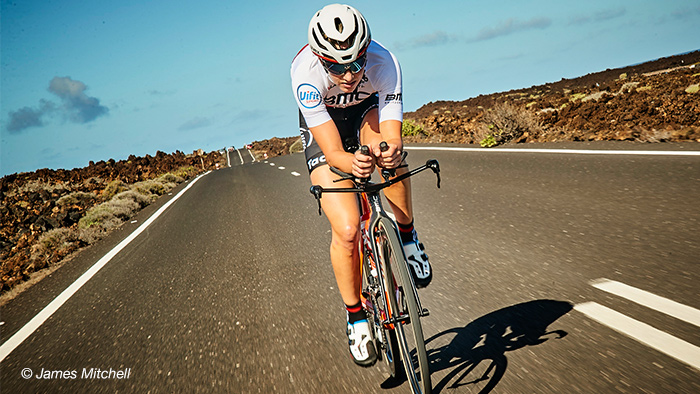You picked out your “A” race. You have a training plan. You’re doing the work. How do you make sure you are progressing? Even more importantly, how do you ensure your progress is the right kind of progress that will allow you to be at your best on race day?
I am a firm believer that to accomplish any endurance goal you need:
- A clear understanding of where your fitness and skillset currently is.
- Where you want your fitness and skillset to be.
- A detailed plan of how to reach that fitness.
- A clear process to evaluate your progress (or lack thereof).
It’s important to know what your current characteristics are and how well they match the requirements of your chosen event. This will highlight areas that need to be addressed. With those areas in mind, you can then build a plan and implement a process to keep track of the adaptations and gains that are needed to succeed in your event.
It is my opinion that following a process such as this will maintain focus on what’s important for your success and prevent devoting precious training time developing adaptations that will not benefit you on race day.
Focus on what’s important.
We can all agree that improving your 100-meter sprint time will not correspond to the best marathon performance. Yet, I see many athletes focusing on specific training protocols and tests that have little to no correlation with what will be required on race day.
In doing so, they benchmark their performance and fitness gains in ways that will not benefit them in their race. That is where having a plan detailing the improvements you need to make will keep you on course to success.
Identifying what you want to achieve and planning to do so is great, but how do we go about making sure we are on track? What tools do we have available to quickly and easily track our improvement?
As it turns out, there are a lot of tools out there that can do just that. I use TrainingPeaks with my athletes and I find there are a few key metrics and charts that help me track their improvement.
Build and track your aerobic engine.
Triathlon is an aerobic sport. Long course triathlon, with its extreme distances, requires not only endurance but also efficiency to maximize performance per unit of effort. Increasing our aerobic engine is therefore paramount.
An easy way to identify progress in one’s aerobic engine is to look at the relationship between heart rate and power or pace. This is called Efficiency Factor (EF) in TrainingPeaks and is a summary statistic calculated for any workout that has heart rate and power/pace data.
As fitness is built, an athlete should expect to see improvement in the power or pace they can hold at any given heart rate. By plotting EF over time, an athlete can confirm that improvements are indeed being made and the athlete is getting fitter and can do more work for the same cardiac output.
Endurance is a clear necessity in long course triathlon, but the story doesn’t end there. At some point an athlete has enough endurance to complete the race. What they need to develop now is the ability to sustain the highest power or pace for the race duration—stamina.
Use the data.
In the TrainingPeaks Dashboard on the desktop platform, I often look at the Peak Power or Pace Chart to get a first glimpse of an athlete’s stamina, or ability to sustain power over long periods of time. The power version is most often used with cycling, but it is also available for running with the advent of the running power meter. For those who do not own a running power meter the Peak Pace Chart will be used for running. I recommend using this chart in several ways.
The shape of the right side of the curve, the longer durations, will give you an idea of an athlete’s stamina: the ability to sustain power over long periods. The shape of the left side gives an insight into the riding and running habits of the athlete by providing insight on the amount and type of speed work performed.
The chart can also be configured showing a comparison of different time periods. This is particularly helpful to highlight progress and confirm that the desired adaptations are being developed. It is also highly reassuring and motivating for an athlete who put in a lot of hard work to increase their ability to sustain power or pace to see that all the hard work has paid off with a tangible improvement.
Another great way to evaluate your progress is to chart your top 10 best power or pace performances over a given period; TrainingPeaks mobile allows up to the Top 20 Peak Performances to be displayed.
This will allow an athlete to see if peak performances are “clustering” at the appropriate time. For example, an IRONMAN athlete working to extend her stamina can confirm she is achieving her training goals by seeing that most of her top 10 best 60, 90 and 180-minute power or pace performances are concentrated at the end of the specifically targeted block.
Throughout the training cycle this chart can be used to confirm the athlete is adapting to the specific training focus. Blocks focusing on anaerobic capacity, VO2 max, Functional Threshold Power (FTP) and sub-maximal stamina should correlate with “peak clusters” for the corresponding time durations. Visual and tangible feedback confirming the training is working can be a powerful validation for an athlete.
Look out for common scenarios giving you inaccurate progress readings.
It is common to see a steep drop in power after 20 minutes or so. This is a result of the standard 20-minute FTP training and testing protocols. The are a few shortcomings, in my opinion, to these protocols.
Athletes will most likely estimate their FTP as 95 percent of their 20-minute power and consistently try to increase their power for that duration. This will do little to develop the stamina to hold sub-maximal power for the extended periods required for a 70.3 or IRONMAN bike leg.
IRONMAN 70.3 bike legs power averages for amateurs range in the 78 to 85 percent of FTP, while for a IRONMAN the range is 68 to 75 percent of FTP. Further, although this FTP estimate is relatively accurate for many athletes, it is not so for all. It tends to overestimate one’s true FTP due to every athlete’s unique physiology determining the anaerobic contribution to achieve power over that duration.
Another common occurrence is very high values on the right side of the chart (five minutes or shorter). This is a telltale sign of group/club rides that usually entail attacks and recoveries. A deeper dive will usually reveal that the athlete spends most of their time either at FTP and above or in recovery zones.
This may also deceivingly manifest as an apparently flat extended duration power curve since those attacks and recoveries will average out over the ride. I use the Variability Index, or VI, (Normalized Power/ Average Power) as a guide to determine how “steady” a ride is. A VI of 1.05 or lower is commonly considered to be steady and ideal for long course triathlon cycling.
If you ride with a group or club, or just tend to have some rides display a very high VI, I would recommend “tagging” those rides so they can be selectively excluded from your steady state training to ensure you are seeing a clear picture of your training and be able to chart real progress in stamina. ed note: This tagging option is only available in WKO4. Learn about WKO4 for more file analysis options.
Consistently high values on the short end (left side) of the curve indicate training of the anaerobic energy systems that contribute to power production. Unfortunately, it is not possible to train ALL energy systems at once. Working on your short end power will tend to have a negative effect on your FTP and stamina and the reverse is also true.
Ideally, you would like to see a shift in the duration of the efforts toward longer, sub-maximal intensity more in line with race day requirements as the training progresses and race day nears. At the very least, you would like to see an improvement over the durations that most closely correlate with the race requirements.
Bring it all together.
A well-structured training program should progress the focus to maximize the accumulated effect of past training with the goal of achieving optimal performance on race day. Monitoring these metrics and charts (there are many more but not nearly enough time to go over them all!) will allow an athlete to confirm they are making the necessary gains in the performance metrics that will most benefit their race.
Long course racing is based on steady efforts and the ability to sustain sub-maximal power outputs for extended periods of time. Focusing the training on developing this ability and having confirmation that the ability has improved will certainly improve performance as well as provide the athlete with the confidence to tackle their race.
Having a clear plan of what you need to achieve, along with leveraging the available technology and tools to confirm you are on track to maximize your adaptations (and to course correct when necessary) will lead to optimal race day performance.



